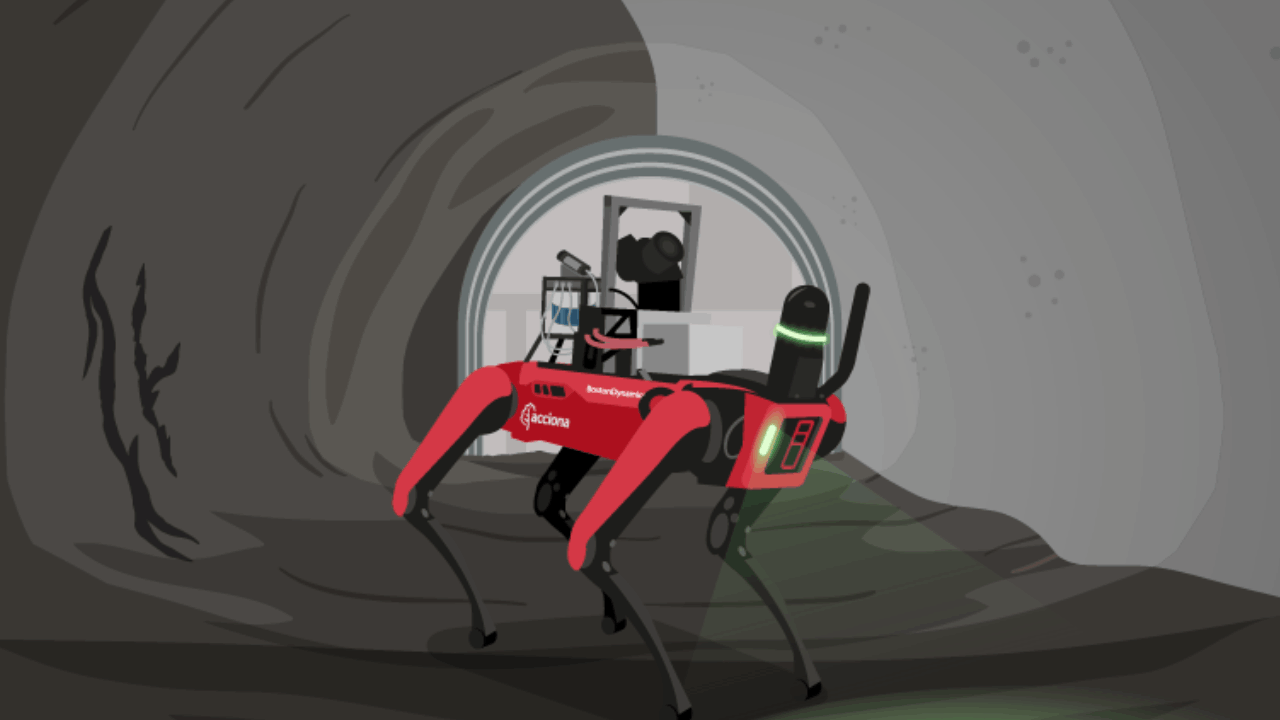After twenty years of arduous travel—wracked by conflict, storms, and mythic ordeals—an older, battle-worn Odysseus finally stepped onto the shores of his homeland, Ithaca. His son Telemachus, just learning to walk when his father left, could not recognize him, nor could most of the household. Only Argus, the aged house dog, mustered a feeble tail wag of welcome, proving his loyalty one last time.
A few centuries later, on the opposite side of the Atlantic, the xoloitzcuintle emerged in Aztec lore as the faithful dog guiding departed souls through Mictlán, the pre-Hispanic underworld.
In present-day Chile, at the Chuquicamata copper mine, rumor has it that miners instinctively reached out to pat Spot—the ACCIONA robot at work in the mine’s tunnels. Spot is purely mechanical, yet it’s shaped like a dog to harness that timeless bond of trust between humans and canines.
Although Spot feels no canine emotions, it shares the dog’s ability to safeguard and assist people in challenging conditions—from treacherous mine shafts to vast railway tunnels. Read on to discover more about this remarkable ally.
This robot, already in use at some of the world’s most demanding engineering projects, is the culmination of years of research and development by Boston Dynamics. Through several generations, it has evolved into an ideal partner for teams facing hazardous environments.
Spot’s earliest ancestor was BigDog, introduced in 2005 and tipping the scales at over a hundred kilograms. It was followed by LittleDog in 2009, AlphaDog Proto in 2011, and the first iteration of Spot in 2015.
The current model runs for around ninety minutes on a single charge and can complete a range of tasks on its own, thanks to modular attachments for different purposes. The unit we deploy has been fully customized—both hardware and software—by our in-house innovation teams, ensuring it meets the specific demands of underground worksites.
Spot first ventured into the tunnels of the Chuquicamata copper mine in Chile’s Antofagasta region back in 2021. This mine, at the time recognized as the largest copper mine on earth, is a critical link in the global push for electrification. Our robot had a key role to play in a high-stakes environment: tunnelling operations carry the dangers of cave-ins, toxic gases, and the risk of serious falls.
During those initial trials, Spot was in a pilot phase, helping us understand its real-world capabilities. We discovered that it could handle time-consuming and perilous tasks, effectively sparing human workers from some of the most hazardous conditions. Typically, at the early stages of any tunnel excavation, things are unstable, so a foreman would need to go in. Spot’s performance revealed that it could step into these vulnerable zones with surprising efficiency and versatility.
During its early assignments in Chuquicamata, Spot excelled in several key tasks:
- Photogrammetry: With a 3D camera, Spot rapidly captures high-definition images of the tunnel’s interior—up to six times faster than manual surveys.
- Pre-shotcrete scanning: Before stabilizing the tunnel walls with concrete, an excavation profile must be documented. Spot enters hard-to-reach areas, cutting the process from 45 minutes down to three.
- Post-shotcrete scanning: Once the concrete is applied, Spot compares tunnel measurements from before and after to reveal any thin spots that need attention.
- Thermography and early strength checks: Using a thermal camera, Spot determines if the concrete has cured and identifies any moisture or weak areas that could lead to cave-ins if not remedied.
After each shift, Spot returns to its charging station, where all collected images and data are analysed. Engineers often spot problems just by examining these visuals but pairing that human expertise with artificial intelligence magnifies efficiency, allowing almost instant detection of critical flaws.
Barry was a St Bernard who, in the early 19th century, earned fame and acclaim for his heroic rescue missions, including saving more than forty pilgrims on their trek to Rome across the Alps. In its own way, our four-legged ally is also helping to save lives—and has been acknowledged for it: Spot won the 2022 ITA Tunnel Awards in the Best Equipment and Product Innovation category.
At ACCIONA, we view technology and innovation as tools that serve people. Spot is just one example of how we put them into practice to safeguard human lives and boost the sustainability of our projects. Another demonstration of this approach, also focused on the underground world, is our use of immersive reality for monitoring and operating tunnel-boring machines, which you can explore in this story.
